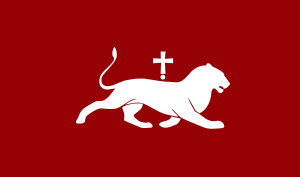Bagratuni family tree
This article needs additional citations for verification. (August 2015) |
Bagratuni family tree describes the heritage of the Bagratuni family in Armenia (Bagratuni dynasty) and Georgia (Bagrationi dynasty).
Kingdom of Armenia[]

The Bagratuni family became princes in the 4th century. Their heritable rights were given to them by the Arshakuni Dynasty, the kings of Armenia (52–428). They were called aspets and crowned Arshakuni kings. Their domain included the region of Sper in Upper Armenia, which was famous for its gold, and Tayk.
Smbat I was the first member of the dynasty. He was aspet during the reign of Armenia's first Christian king, Tiridates III the Great (287–330). The last Armenian king, who was crowned by Bagratunis, was Artaxias IV (423–428). The aspet was Smbat III, who was known from Vramshapuh king's times (389–415).
| showFamily of Bagratuni family tree |
|---|
Persian and Byzantine occupation[]
The ancestors of Smbat III were the most famous princes (nakharars) during the occupation of the Roman Empire and Sassanid Persia. Armenia had been divided between them since 387. Tirots, one of the ancestors of Smbat III, allied with Armenian marzbane. Sahak II and Smbat IV were marzbans of Armenia. The rulers of the dynasty traditionally continued to be "aspets".
After the second division of Armenia, the domains of the Bagratuni family became part of Byzantine Empire. Smbat IV was among the princes who rebelled against them.
| History of Armenia |
|---|
 |
| Timeline • Origins • Etymology |
| showFamily of Bagratuni family tree |
|---|
Arabic Caliphate[]

During the Arabic period (7–9th centuries), the Bagratuni family was one of the most powerful princely dynasties of Armenia. Their main competitors were sparapets of the Mamikonian family who were Byzantine-oriented. Princes of Armenia were chosen from these two families and sometimes the people, who were under their influence. Princes were the second most powerful people after the ostikan.[citation needed]
The competition was ended by the victory of Bagratunis, who founded an independent kingdom. First, the title of Prince of Armenia changed to Prince of Princes. Then, the prince of princes became sparapets who were the constables of the army. In the beginning of the 9th century, a powerful prince, Ashot Msaker, united Taron, Tayk and Ayrarat, taking them under his control and thus making them part of his domain. Later, he united Moxoene, Gugark, Georgia and Caucasian Albania. He then took over Artsrunis of Vaspurakan and Syunis of Syunik. As a result, all of Arminiya came under his control.[citation needed]
Princes of Armenia and sparapets were from the family of Smbat VIII. His son, Ashot, became the king of Armenia. Sons of Bagarat II, brother of Smbat VIII, became the princes of Taron. Their sister, Hripsime, became the princess of principality of Vaspurakan. Her husband was the first prince Hamazasp II, Artsruni.[citation needed]
Before independence, the Tayk of Bagratuni became an independent principality.[citation needed] Its ruler, Ashot, became the head of the Georgian Bagrationi dynasty. It ruled in Georgia for one thousand years (9–19th centuries).
The last prince of Armenia was Ashot (855–885), son of Smbat VIII, who later became the first king (885–890).
| showFamily of Bagratuni family tree |
|---|
Bagratid kingdom of Armenia[]
Bagratunis of Taron[]

Taron (Turuberan) became a part of Bagratunis' domain in the beginning of the 9th century, when Ashot Msaker was Prince of Armenia (790–826). As a prince of Taron, he is counted as Ashot I (804–826). After his death, prince of princes, Bagrat, inherited Taron, the south of the domain, and Smbat, Ayrarat, which was the northern part. Bagrat was the second in the dynasty. Bagrat I was an aspet in the 4th century. However, in Taron, he was the first Bagrat, so he ruled as Bagrat I of Taron (826–851), because there were no Bagrats before him. His sons and grandsons ruled until 966. After, Taron became a part of Byzantine Empire.[citation needed]
Previous seniors, princes of Taron, of the Mamikonian family, were strong in the region, even during the ruling of the last prince, Ashot III. They became relatives with the Bagratunis, and as a result of that, there were two more princes in Taron in his last days. They were Bagrat III and Grigor II, who were half-Mamikonians and half-Bagratunis. Later, the Tronite branch of the Bagratunis and Mamikonians became one family. Some of them ruled in Sasun (Tornikians) and the others in Moush (Taronites).[citation needed]
| showFamily of Bagratuni family tree |
|---|
- Family trees
- Bagrationi dynasty
- Bagratuni dynasty
- Armenia-related lists
- Georgia (country)-related lists

